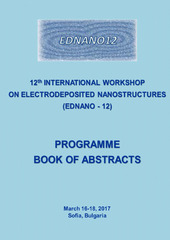Приказ основних података о документу
Comparative analysis of chemically and electrochemically produced silver powders of nanostructural characteristics
| dc.creator | Nikolić, Nebojša D. | |
| dc.creator | Avramović, Ljiljana | |
| dc.creator | Maksimović, Vesna | |
| dc.creator | Pavlović, Miroslav | |
| dc.creator | Perać, Sanja | |
| dc.creator | Stevanović, Jasmina | |
| dc.creator | Bugarin, Mile | |
| dc.date.accessioned | 2023-09-28T12:17:38Z | |
| dc.date.available | 2023-09-28T12:17:38Z | |
| dc.date.issued | 2017 | |
| dc.identifier.uri | https://cer.ihtm.bg.ac.rs/handle/123456789/6650 | |
| dc.description.abstract | Silver powder particles of nanostructured characteristics were produced by the galvanostatic regime of electrolysis and compared with those obtained by chemical reduction with hydrazine. Morphology of all types of powder particles was examined by the technique of scanning electron microscopy (SEM), while crystallographic characteristics were examined by the X-ray diffraction (XRD) analysis of the obtained particles. Morphology of the electrochemically produced powder particles strongly depended on the type of used electrolyte. The irregular crystals and the needle-like dendrites were predominately formed from the nitrate (acid) electrolyte. On the other hand, the 3D pine-like dendrites very similar to Cu dendrites [1] were formed by the electrodeposition from the ammonium (alcali) electrolyte. Simultaneously, the particles of spherical shape were formed by chemical reduction with hydrazine. The difference in morphology of electrochemically produced Ag powders can be explained by different rate of the electrochemical process by which they are formed. Namely, the ammonium electrolyte belongs to the group of the complex electrolyte and formation of this complex lowers the exchange current density for Ag causing a transfer of Ag from the group of the normal metals (metals with the high values of the exchange current density) to the group of the intermediate metals (metals with the medium values of the exchange current density). Irrespective of the way of preparation of Ag powder, Ag crystallites in all types of powder particles were predominantly oriented in the (111) plane. Formation of powder particles of the different shape with the strong (111) preferred orientation was discussed and explained by the consideration of the general characteristics of the growth of a crystal in the crystallization and electrocrystallization processes. Analogy between these two types of processes was made and discussed. | sr |
| dc.language.iso | en | sr |
| dc.publisher | Bulgaria, Sofia : Institute of Physical Chemistry, Bulgarian Academy of Science | sr |
| dc.rights | openAccess | sr |
| dc.rights.uri | https://creativecommons.org/licenses/by/4.0/ | |
| dc.source | Programme and Book of Abstracts - 12th International Workshop on Electrodeposited Nanostructures (EDNANO - 12), March 16-18, Sofia, Bulgaria | sr |
| dc.subject | silver powder | sr |
| dc.subject | hydrazine | sr |
| dc.subject | galvanostatic regime | sr |
| dc.subject | chemical reduction | sr |
| dc.title | Comparative analysis of chemically and electrochemically produced silver powders of nanostructural characteristics | sr |
| dc.type | conferenceObject | sr |
| dc.rights.license | BY | sr |
| dc.citation.spage | 47 | |
| dc.citation.epage | 47 | |
| dc.identifier.rcub | https://hdl.handle.net/21.15107/rcub_cer_6650 | |
| dc.identifier.fulltext | http://cer.ihtm.bg.ac.rs/bitstream/id/27085/M34-7.pdf | |
| dc.type.version | publishedVersion | sr |


